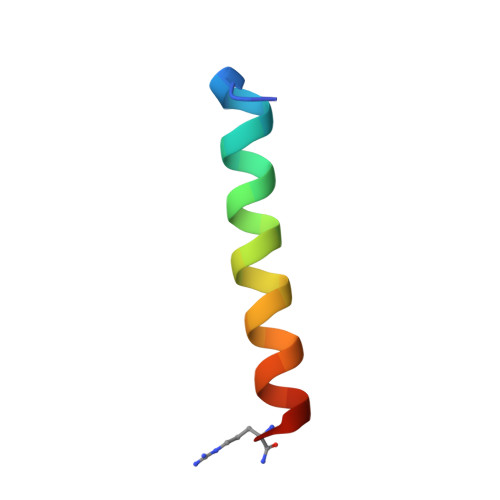Biophysical Characterization of Pro-apoptotic BimBH3 Peptides Reveals an Unexpected Capacity for Self-Association.
Assafa, T.E., Nandi, S., Smilowicz, D., Galazzo, L., Teucher, M., Elsner, C., Putz, S., Bleicken, S., Robin, A.Y., Westphal, D., Uson, I., Stoll, R., Czabotar, P.E., Metzler-Nolte, N., Bordignon, E.(2021) Structure 29: 114-124.e3
- PubMed: 32966763
- DOI: https://doi.org/10.1016/j.str.2020.09.002
- Primary Citation of Related Structures:
6X8O - PubMed Abstract:
Bcl-2 proteins orchestrate the mitochondrial pathway of apoptosis, pivotal for cell death. Yet, the structural details of the conformational changes of pro- and antiapoptotic proteins and their interactions remain unclear. Pulse dipolar spectroscopy (double electron-electron resonance [DEER], also known as PELDOR) in combination with spin-labeled apoptotic Bcl-2 proteins unveils conformational changes and interactions of each protein player via detection of intra- and inter-protein distances. Here, we present the synthesis and characterization of pro-apoptotic BimBH3 peptides of different lengths carrying cysteines for labeling with nitroxide or gadolinium spin probes. We show by DEER that the length of the peptides modulates their homo-interactions in the absence of other Bcl-2 proteins and solve by X-ray crystallography the structure of a BimBH3 tetramer, revealing the molecular details of the inter-peptide interactions. Finally, we prove that using orthogonal labels and three-channel DEER we can disentangle the Bim-Bim, Bcl-xL-Bcl-xL, and Bim-Bcl-xL interactions in a simplified interactome.
Organizational Affiliation:
Faculty of Chemistry and Biochemistry, Ruhr University Bochum, Bochum, Germany.















